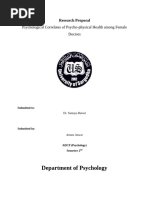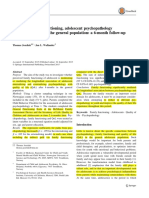M1 - ANCS - 2023-2024 - PCSI - Summary - ALOUANE - Impact of Psychotic Traits On Identity
M1 - ANCS - 2023-2024 - PCSI - Summary - ALOUANE - Impact of Psychotic Traits On Identity
Uploaded by
zelalouaneCopyright:
Available Formats
M1 - ANCS - 2023-2024 - PCSI - Summary - ALOUANE - Impact of Psychotic Traits On Identity
M1 - ANCS - 2023-2024 - PCSI - Summary - ALOUANE - Impact of Psychotic Traits On Identity
Uploaded by
zelalouaneOriginal Title
Copyright
Available Formats
Share this document
Did you find this document useful?
Is this content inappropriate?
Copyright:
Available Formats
M1 - ANCS - 2023-2024 - PCSI - Summary - ALOUANE - Impact of Psychotic Traits On Identity
M1 - ANCS - 2023-2024 - PCSI - Summary - ALOUANE - Impact of Psychotic Traits On Identity
Uploaded by
zelalouaneCopyright:
Available Formats
Zélie ALOUANE
22009631
Impact of psychotic traits and family functioning on identity
Psychosis is a major area of interest within the field of psychology, and concepts of identity
and family functioning are at the heart of the understanding of the topic. However, much of
the research up to now evaluated psychosis from the perspective of pathology rather than a
personality trait. This study therefore set out to assess the association between identity,
family functioning, and psychotic traits among the general population.
Social identity alterations may emerge in the context of psychotic disorders, due to specific
symptoms, such as paranoia, flattened affects, or social anhedonia (McIntyre et al., 2018).
These patients could struggle with interpersonal relationships but also to integrate into a
job, a leisure activity, or a community. Interpersonal difficulties seem to appear in early
childhood since the bounding quality is lower for these patients than in the general
population (Carr et al., 2018). This relation could be explained by family dysfunction during
childhood and adolescence. Indeed, recent research shows that dysregulation in family
functioning is correlated with early episodes of psychosis (Santesteban-Echarri et al., 2018).
Furthermore, childhood and adolescence are critical moments for the construction of
identity (Erickson, 1978). Therefore, a dysregulation of family functioning may lead to an
alteration of identity, including social identity.
These findings suggest that psychotic traits are related to identity and that the quality of
family functioning modulates this link. More specifically, psychotic traits should be
negatively
correlated to identity and quality of family functioning, nevertheless, the quality of family
functioning should reduce the impact of psychotic traits on identity.
108 participants were recruited for this study; three questionnaires were submitted,
assessing the quality of family functioning during childhood, the intensity of psychotic
traits, and involvement in several aspects of identity. Linear regressions were conducted to
analyze the data.
This research should not only fill a gap in the literature but also contribute to developing
family prevention programs for at-risk adolescents. Nonetheless, further research should
utilize a qualitative design to explore individual’s subjective perceptions of their own
families.
You might also like
- Revit MEP Training Manual PDFDocument196 pagesRevit MEP Training Manual PDFHugo Böttger Alor100% (6)
- F8 Notes Ahmed ShafiDocument69 pagesF8 Notes Ahmed ShafiMubashirNo ratings yet
- 01.the Study of The Family - JacksonDocument10 pages01.the Study of The Family - JacksonErnesto ContrerasNo ratings yet
- Civpro DigestDocument37 pagesCivpro DigestArahbellsNo ratings yet
- Understanding The Self G.E. 3: University of Eastern PhilippinesDocument22 pagesUnderstanding The Self G.E. 3: University of Eastern Philippinesbladdor DG.67% (3)
- 2020 - Sluggish Cognitive Tempo in Adolescents With and Without ADHD - Differentiation From Adolescent-Reported ADHD Inattention and Unique Associations With Internalizing DomainsDocument16 pages2020 - Sluggish Cognitive Tempo in Adolescents With and Without ADHD - Differentiation From Adolescent-Reported ADHD Inattention and Unique Associations With Internalizing DomainsRaúl VerdugoNo ratings yet
- 2018 Self-Conceptclaritymediatestheeffectsofadversechildhoodexperiencesonadultsuicidebehaviordepressionlonelinessperceivedstressandlife WongDirghangiHartDocument21 pages2018 Self-Conceptclaritymediatestheeffectsofadversechildhoodexperiencesonadultsuicidebehaviordepressionlonelinessperceivedstressandlife WongDirghangiHartLaraib ShahNo ratings yet
- Attachment Representation To Caregivers and Mentalizing Ability in Early Adolecents With Primary HeadcheDocument10 pagesAttachment Representation To Caregivers and Mentalizing Ability in Early Adolecents With Primary HeadcheRichy ValenzuelaNo ratings yet
- The Relationship Between Family Communication Patterns and Mental HealthDocument13 pagesThe Relationship Between Family Communication Patterns and Mental HealthJasmine MabanagNo ratings yet
- Tankersley 2011Document10 pagesTankersley 2011bordian georgeNo ratings yet
- Buck, K. A. (2015) - Understanding Adolescent Psychopathic Traits From Early Risk and Protective FactorsDocument9 pagesBuck, K. A. (2015) - Understanding Adolescent Psychopathic Traits From Early Risk and Protective FactorsMartinaNo ratings yet
- The Role of Thought Suppression and Psychological InflexibilityDocument8 pagesThe Role of Thought Suppression and Psychological InflexibilityNurul rizki IsnaeniNo ratings yet
- Clin Psychology and Psychoth - 2021 - Erkoreka - Attachment Anxiety As Mediator of The Relationship Between ChildhoodDocument11 pagesClin Psychology and Psychoth - 2021 - Erkoreka - Attachment Anxiety As Mediator of The Relationship Between Childhoodmariam ahmad maulanaNo ratings yet
- Chapter 2 Review QuestionsDocument4 pagesChapter 2 Review Questionskhushivash1306No ratings yet
- Preprints201610 0047 v1 PDFDocument11 pagesPreprints201610 0047 v1 PDFYelysey NizyevNo ratings yet
- Parental Warmth and Hostility and The DevelopmentDocument12 pagesParental Warmth and Hostility and The DevelopmentEuneel EscalaNo ratings yet
- Psychopaths: Born or Made?Document14 pagesPsychopaths: Born or Made?Jinwee ThermoplastiqueNo ratings yet
- Bechaida, Marife D. - Chapters 123Document33 pagesBechaida, Marife D. - Chapters 123Marife BechaidaNo ratings yet
- Biological Perspective On Personality: Course: Personality Theories (Psy 711) Lecturer: DR AyodejiDocument24 pagesBiological Perspective On Personality: Course: Personality Theories (Psy 711) Lecturer: DR AyodejiIkponmwosa EseosaNo ratings yet
- Total 1Document16 pagesTotal 1kingcanva3No ratings yet
- Parenting Style and Adolescent Mental Health The Chain Mediating Effects of Self-Esteem and Psychological InflexibilityDocument11 pagesParenting Style and Adolescent Mental Health The Chain Mediating Effects of Self-Esteem and Psychological InflexibilitygksgksenenNo ratings yet
- Fpsyt 12 744976Document11 pagesFpsyt 12 744976ousamamecherguiNo ratings yet
- Psychological GeneticsDocument24 pagesPsychological GeneticsdevNo ratings yet
- Mental Health States of Housewives: An Evaluation in Terms of Self Perception and CodependencyDocument18 pagesMental Health States of Housewives: An Evaluation in Terms of Self Perception and CodependencyRocio MarquezNo ratings yet
- SchizophreniaDocument14 pagesSchizophrenianehagupta.ma22No ratings yet
- Wang Et Al., 2020Document12 pagesWang Et Al., 2020Just a GirlNo ratings yet
- Jabeen & TahirDocument12 pagesJabeen & TahirSanaNo ratings yet
- 1 s2.0 S0165178117319030 MainDocument9 pages1 s2.0 S0165178117319030 MainManu JimenezNo ratings yet
- 16 de Septiembre ArticuloDocument12 pages16 de Septiembre ArticuloLina María MoncadaNo ratings yet
- Family Drawing and Psychological Vulnerability in Children S Representations of Parental DivorceDocument15 pagesFamily Drawing and Psychological Vulnerability in Children S Representations of Parental DivorceEcaterina IacobNo ratings yet
- Synopsis AIMEN ANWAR ADCP (1)Document8 pagesSynopsis AIMEN ANWAR ADCP (1)sababajwa48280No ratings yet
- Parenting, Marital Conflict and Adjustment From Early-To Mid-Adolescence: Mediated by Adolescent Attachment Style?Document14 pagesParenting, Marital Conflict and Adjustment From Early-To Mid-Adolescence: Mediated by Adolescent Attachment Style?Khoyrunnisaa AnnabiilahNo ratings yet
- Bezdjian Et Al - 2011 - Psychopathic Personality in Children-Genetic and Environmental ContributionsDocument18 pagesBezdjian Et Al - 2011 - Psychopathic Personality in Children-Genetic and Environmental ContributionsAndrew Myles-WrightNo ratings yet
- The Moderating Effect of Self-Esteem On The Relationship Between Perceived Social Support and Psychological Well-Being Among AdolescentsDocument14 pagesThe Moderating Effect of Self-Esteem On The Relationship Between Perceived Social Support and Psychological Well-Being Among AdolescentsPsychology and Education: A Multidisciplinary JournalNo ratings yet
- Famp 12276Document23 pagesFamp 12276alejandro.manzano.caceresNo ratings yet
- Social RelationshipDocument7 pagesSocial RelationshipAurelia AnankeNo ratings yet
- SSM 2021 Caregiving Will Enhance Grandparents' Mental HealthDocument8 pagesSSM 2021 Caregiving Will Enhance Grandparents' Mental HealthciaofotografinNo ratings yet
- AnxietyDocument3 pagesAnxietyFrances TaganasNo ratings yet
- Perception of Family Functioning: Parental vs. Non-Parental PerspectiveDocument11 pagesPerception of Family Functioning: Parental vs. Non-Parental Perspectiveaya.mejriNo ratings yet
- 3-2 Milestone One- Annotated BibliographyDocument6 pages3-2 Milestone One- Annotated BibliographytashiaNo ratings yet
- The relationship between adolescents’ social anxiety levelDocument11 pagesThe relationship between adolescents’ social anxiety levelrykrg92fp7No ratings yet
- Psychopathy, Aggression, and The Processing of Emotional Stimuli in Non-Referred Girls and BoysDocument17 pagesPsychopathy, Aggression, and The Processing of Emotional Stimuli in Non-Referred Girls and BoysRealidades InfinitasNo ratings yet
- Marsha Linehan - A Biosocial Developmental Model of Borderline Personality: Elaborating and Extending Linehan's TheoryDocument16 pagesMarsha Linehan - A Biosocial Developmental Model of Borderline Personality: Elaborating and Extending Linehan's TheoryIrving Pérez MéndezNo ratings yet
- Psychosocial Health'Document8 pagesPsychosocial Health'hadiNo ratings yet
- NUEVO - Emotional Intelligence and Cognitive Skills Protecting Mental Health From Stress and Violence Among Ghanaian YouthDocument9 pagesNUEVO - Emotional Intelligence and Cognitive Skills Protecting Mental Health From Stress and Violence Among Ghanaian Youthdaniella aleanNo ratings yet
- Perceived Family Functioning Adolescent Psychopathology and Quality of Life in General Population A 6 Month Follow Up StudyDocument9 pagesPerceived Family Functioning Adolescent Psychopathology and Quality of Life in General Population A 6 Month Follow Up StudyMarisolNo ratings yet
- Stavrova Et Al 2022 Estranged and Unhappy Examining The Dynamics of Personal and Relationship Well Being SurroundingDocument27 pagesStavrova Et Al 2022 Estranged and Unhappy Examining The Dynamics of Personal and Relationship Well Being SurroundingSolomonelNo ratings yet
- Meta-Analyses of The Associations of Mentalization and Proxy Variables With Anxiety and Internalizing ProblemsDocument13 pagesMeta-Analyses of The Associations of Mentalization and Proxy Variables With Anxiety and Internalizing ProblemsmbemartiNo ratings yet
- Ferraro 2021Document7 pagesFerraro 2021Hegymegi-Kiss DalmaNo ratings yet
- Sociomoral Temperament A Mediator Between WellbeinDocument16 pagesSociomoral Temperament A Mediator Between WellbeinJovana MarNo ratings yet
- 10 PDFDocument12 pages10 PDFPavel DianaNo ratings yet
- The Relationship Among Attributional Style, Mentalization, and Five Anxiety Phenotypes in School-Age ChildrenDocument16 pagesThe Relationship Among Attributional Style, Mentalization, and Five Anxiety Phenotypes in School-Age ChildrenTSGNo ratings yet
- Gender Inequality in Household Chores and Work-Family ConflictDocument11 pagesGender Inequality in Household Chores and Work-Family Conflict17Annisa Muthmainnah067No ratings yet
- TAHA AHMAD Research Paper Draft 2Document9 pagesTAHA AHMAD Research Paper Draft 2Taha AhmadNo ratings yet
- International Journal of Clinical and Health PsychologyDocument9 pagesInternational Journal of Clinical and Health PsychologyAna Carolina SandovalNo ratings yet
- Anxious SymptomsDocument7 pagesAnxious Symptomst mdeNo ratings yet
- tmp2548 TMPDocument7 pagestmp2548 TMPFrontiersNo ratings yet
- Friendship Quality and Personality As Predictors of PsychologicalDocument27 pagesFriendship Quality and Personality As Predictors of PsychologicalRamona ViceNo ratings yet
- College Student Chaotically.. Indirect Effect of ComunicationDocument24 pagesCollege Student Chaotically.. Indirect Effect of ComunicationBidang Pendidikan YIMKNo ratings yet
- Children Living With A Parent Who Has A Mental Illness A Critical Analysis of The Literature and Research ImplicationsDocument9 pagesChildren Living With A Parent Who Has A Mental Illness A Critical Analysis of The Literature and Research Implicationsred0darkNo ratings yet
- ICU EspañolDocument10 pagesICU EspañolAntonioNo ratings yet
- Acasa 1longitudinalDocument10 pagesAcasa 1longitudinalmudeteNo ratings yet
- Hunger: Mentalization-based Treatments for Eating DisordersFrom EverandHunger: Mentalization-based Treatments for Eating DisordersRating: 1 out of 5 stars1/5 (1)
- Writing Emails and LettersDocument6 pagesWriting Emails and Letterswei zhouNo ratings yet
- Diss Exam 2ndDocument7 pagesDiss Exam 2ndCherry DelicaNo ratings yet
- Shortcut KeysDocument2 pagesShortcut KeysGudapati SurendranadhchowdharyNo ratings yet
- Amherst Town Meeting OML ComplaintDocument14 pagesAmherst Town Meeting OML Complaintlarry_kelley_1No ratings yet
- CS402 - AL102 Module 1Document4 pagesCS402 - AL102 Module 1Daisy Jean CastilloNo ratings yet
- QP10 (NTC)Document14 pagesQP10 (NTC)Saketh MaddamsettyNo ratings yet
- Tectonic Evolution and PaleogeographyDocument24 pagesTectonic Evolution and PaleogeographyIlber Noa AmancaNo ratings yet
- Akips Installation GuideDocument14 pagesAkips Installation GuideHanan AbbasNo ratings yet
- Cooking AdoboDocument3 pagesCooking AdoboRodilyn GuindulmanNo ratings yet
- Sensory Lab ReportDocument15 pagesSensory Lab Reportapi-3010495510% (1)
- McDonalds SWOT AnalysisDocument2 pagesMcDonalds SWOT AnalysisYahya AhmadNo ratings yet
- How To Always Rock-Your LinkedIn Profile PDFDocument34 pagesHow To Always Rock-Your LinkedIn Profile PDFKurasaNo ratings yet
- Cases Airport Security-Civil Action For DamagesDocument16 pagesCases Airport Security-Civil Action For DamagesShimi FortunaNo ratings yet
- Republic v. Bagtas (G.R. No. L-17474, October 25, 1962)Document2 pagesRepublic v. Bagtas (G.R. No. L-17474, October 25, 1962)Lorie Jean Udarbe100% (1)
- Resume - Harman PDFDocument2 pagesResume - Harman PDFHarman8181No ratings yet
- Flyash Halfyearly PDFDocument26 pagesFlyash Halfyearly PDFNilay GandhiNo ratings yet
- Biodata Format FinalDocument3 pagesBiodata Format FinalPratik ChaturvediNo ratings yet
- ALL BANK Approved COMPANY LISTDocument4,760 pagesALL BANK Approved COMPANY LISTcnu11082No ratings yet
- Janssen 2nd D0se 8-5-2021 Updated DianeDocument64 pagesJanssen 2nd D0se 8-5-2021 Updated DianeGanie Mar BiasonNo ratings yet
- AUTISMDocument26 pagesAUTISMMarie YahNo ratings yet
- Pizeta Pharma Corporate Profile 2022Document73 pagesPizeta Pharma Corporate Profile 2022Faruk HossainNo ratings yet
- GE BibliographyDocument33 pagesGE BibliographyEmman P. ArimbuyutanNo ratings yet
- Hostel StudyDocument18 pagesHostel Studyvishal yaduvanshi100% (1)
- Third Eye BlindsemiSemi Charmed Life-Bass2Document6 pagesThird Eye BlindsemiSemi Charmed Life-Bass2FADBASSNo ratings yet
- 1 To 12 Review A1Document3 pages1 To 12 Review A1Eos GonzalezNo ratings yet
- Mas65 Endowment FormDocument1 pageMas65 Endowment FormFahadNo ratings yet

























































































